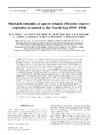Identificador persistente para citar o vincular este elemento:
https://accedacris.ulpgc.es/jspui/handle/10553/49440
| Título: | Stomach contents of sperm whales Physeter macrocephalus stranded in the North Sea 1990-1996 | Autores/as: | Santos, M. B. Pierce, G. J. Boyle, P. R. Reid, R. J. Ross, H. M. Patterson, I. A.P. Kinze, C. C. Tougaard, S. Lick, R. Piatkowski, U. Hernández-García, V. |
Clasificación UNESCO: | 240119 Zoología marina | Palabras clave: | Feeding ecology Cetacea Stranding Gonatus Cephalopoda |
Fecha de publicación: | 1999 | Editor/a: | 0171-8630 | Publicación seriada: | Marine Ecology - Progress Series | Resumen: | Stomach contents of 17 sperm whales Physeter macrocephalus stranded in Scotland and Denmark during 1990-96 were analysed. All were sub-adult or adult males and stranded between November and March. They had presumably entered the North Sea during their southward migration from feeding grounds in Arctic waters. Other studies indicate that the majority of the whales were apparently healthy. The diet of these whales was found to consist almost entirely of cephalopods, principally squid of the genus Gonatus (hereafter 'Gonatus', but probably G. fabricii, an oceanic species characteristic of Arctic waters). The other prey species identified were also mostly oceanic cephalopods: the squids Histioteuthis bonnellii, Teuthowenia megalops and Todarodes sagittatus and the octopus Haliphron atlanticus. Although these results are consistent with other recent studies in the area based on single stranded whales, they differ from results of work on whales caught during commercial whaling operations in Icelandic waters (1960s to 1980s) in that little evidence of predation on fish was found in the present study. Remains of single individuals of the veined squid Loligo forbesi, the northern octopus Eledone cirrhosa and the saithe Pollachius virens provided the only possible evidence of feeding in the North Sea. We infer that sperm whales do not enter the North Sea to feed. The timing, and large and uniform sizes of the Gonatus species eaten (most had mantle lengths in the range 195 to 245 mm), as estimated from measurements of the lower beaks, and the seasonality of the strandings is consistent with the whales having fed on mature squid, possibly spawning concentrations--as has recently been reported for bottlenose whales. Assuming that the diet recorded in this study was representative of sperm whales during the feeding season, as much as 500000 t of Gonatus could be removed by sperm whales in Norwegian waters each year and up to 3 times that figure from the eastern North Atlantic as a whole. Evidence from other studies indicates that Gonatus is an important food resource for a wide range of marine predators in Arctic waters. | URI: | https://accedacris.ulpgc.es/handle/10553/49440 | ISSN: | 0171-8630 | DOI: | 10.3354/meps183281 | Fuente: | Marine Ecology Progress Series [ISSN 0171-8630], v. 183, p. 281-294 |
| Colección: | Artículos |
Citas SCOPUSTM
79
actualizado el 08-jun-2025
Citas de WEB OF SCIENCETM
Citations
70
actualizado el 08-jun-2025
Visitas
67
actualizado el 05-nov-2022
Descargas
187
actualizado el 05-nov-2022
Google ScholarTM
Verifica
Altmetric
Comparte
Exporta metadatos
Los elementos en ULPGC accedaCRIS están protegidos por derechos de autor con todos los derechos reservados, a menos que se indique lo contrario.
